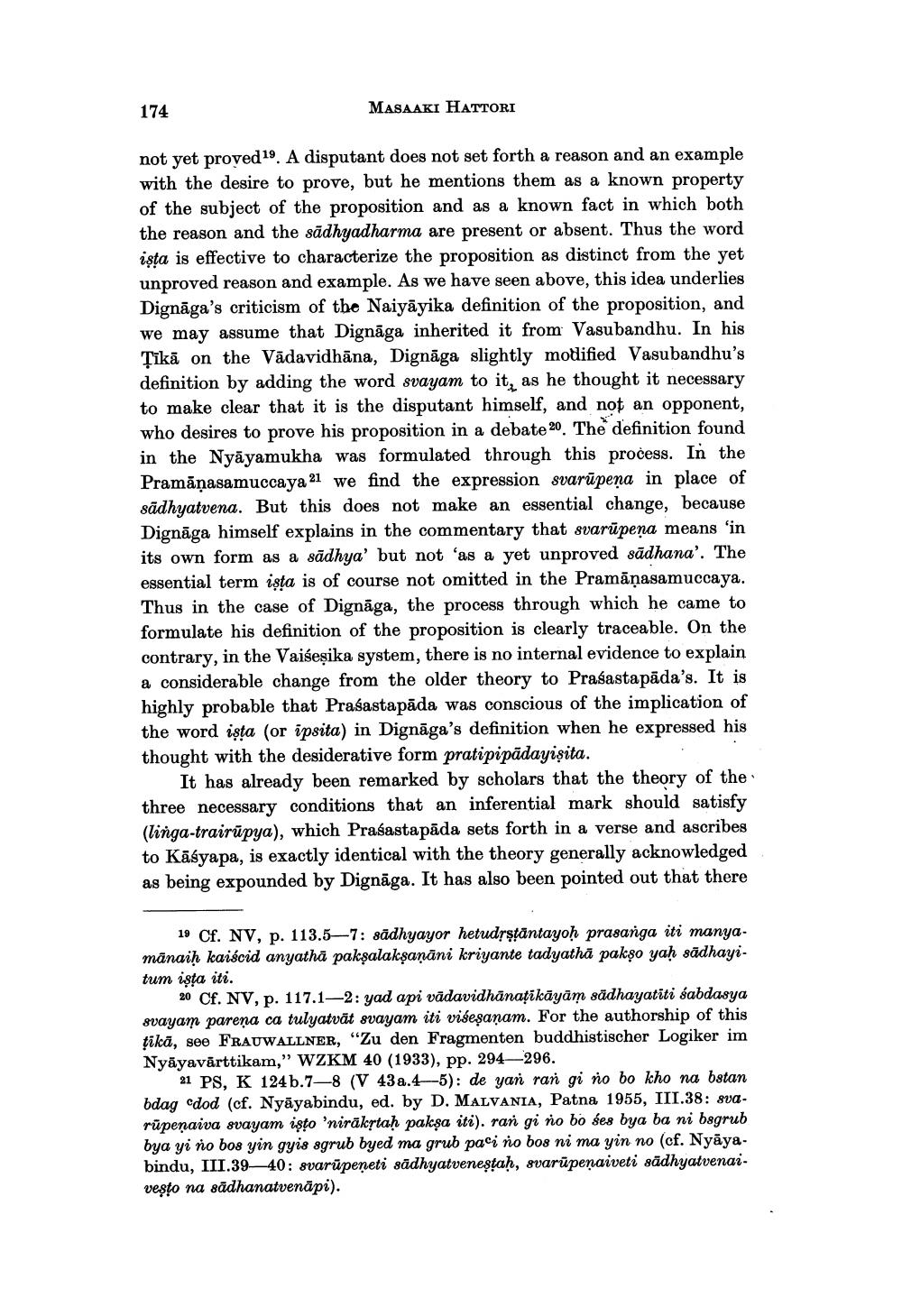Book Title: Note On Development Of Vaisesika Theory Of Anumana Author(s): Masaaki Hattori Publisher: Masaaki Hattori View full book textPage 6
________________ 174 MASAAKI HATTORI not yet proved 19. A disputant does not set forth a reason and an example with the desire to prove, but he mentions them as a known property of the subject of the proposition and as a known fact in which both the reason and the sadhyadharma are present or absent. Thus the word ista is effective to characterize the proposition as distinct from the yet unproved reason and example. As we have seen above, this idea underlies Dignaga's criticism of the Naiyayika definition of the proposition, and we may assume that Dignaga inherited it from Vasubandhu. In his Ţikā on the Vādavidhāna, Dignaga slightly modified Vasubandhu's definition by adding the word svayam to it, as he thought it necessary to make clear that it is the disputant himself, and not an opponent, who desires to prove his proposition in a debate 20. The definition found in the Nyayamukha was formulated through this process. In the Pramanasamuccaya 21 we find the expression svarupena in place of sadhyatvena. But this does not make an essential change, because Dignaga himself explains in the commentary that svarupena means 'in its own form as a sadhya' but not 'as a yet unproved sadhana'. The essential term ista is of course not omitted in the Pramaṇasamuccaya. Thus in the case of Dignaga, the process through which he came to formulate his definition of the proposition is clearly traceable. On the contrary, in the Vaiseṣika system, there is no internal evidence to explain a considerable change from the older theory to Prasastapāda's. It is highly probable that Prasastapāda was conscious of the implication of the word ista (or ipsita) in Dignaga's definition when he expressed his thought with the desiderative form pratipipadayiṣita. It has already been remarked by scholars that the theory of the three necessary conditions that an inferential mark should satisfy (linga-trairupya), which Prasastapāda sets forth in a verse and ascribes to Kasyapa, is exactly identical with the theory generally acknowledged as being expounded by Dignaga. It has also been pointed out that there 19 Cf. NV, p. 113.5-7: sadhyayor hetudṛṣṭantayoḥ prasanga iti manyamanaiḥ kaiścid anyatha pakṣalakṣaṇāni kriyante tadyatha pakso yaḥ sadhayitum ista iti. 20 Cf. NV, p. 117.1-2: yad api vadavidhānaṭīkāyām sädhayatiti sabdasya svayam parena ca tulyatvät svayam iti viśeşanam. For the authorship of this tikā, see FRAUWALLNER, "Zu den Fragmenten buddhistischer Logiker im Nyayavārttikam," WZKM 40 (1933), pp. 294-296. 21 PS, K 124b.7-8 (V 43a.4-5): de yan ran gi no bo kho na batan bdag cdod (cf. Nyayabindu, ed. by D. MALVANIA, Patna 1955, III.38: svarūpeṇaiva svayam isto 'niräkṛtaḥ paksa iti). ran gi no bo ses bya ba ni bsgrub bya yi no bos yin gyis sgrub byed ma grub paci no bos ni ma yin no (cf. Nyayabindu, III.39-40: svarupeneti sadhyatveneṣṭaḥ, svarupenaiveti sadhyatvenaivesto na sadhanatvenapi).Page Navigation
1 ... 4 5 6 7 8 9 10 11 12
